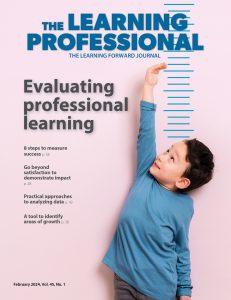Even with hope for the new year still fresh, many educators and students have been traumatized by the events of this week in the U.S. Capitol. Teachers and other school staff – already carrying the heavy burdens of educating during a pandemic and confronting racism and inequity – face the challenging but essential work of helping students process the alarming events and the threats they pose to democracy and civil rights.
We at Learning Forward are heartened by the many resources that organizations and colleagues are sharing about how educators can talk with and support students. As a professional learning organization, we are keenly aware that educators, too, need support in this dark time. District, school, and professional learning leaders can establish a solid and supportive foundation for the hard work of teachers and other staff.
We have compiled some of our recent articles and tools that may help you support staff during this time. We also reached out to Learning Forward members, colleagues, and field leaders for additional resources and advice. Here we share some of the themes, strategies, and ideas that emerged.
Reach out and stay connected
With so much going on in our schools and in our world, it can be hard to find the time to connect with each and every staff member. But those connections are a key part of leadership, because they lay the foundations of trust, learning, and ultimately, good educational practice. Simply letting staff know you are there for them and asking how they are doing can make a big difference. It’s especially important to remember that this week’s events may be particularly triggering for staff members of color and those who have immigrated from other countries where they have experienced political instability.
To help you organize your outreach, you may want to adapt this communication log we published from Turnaround for Children. And if you supervise or support many staff members, you may want to create a plan to share outreach responsibilities with others, like making an old-fashioned phone tree or creating communication channels in vertical teams.
Acknowledge the trauma
As Val Brown, a former member of the Learning Forward Board of Trustees and the Principal Academic Officer at the Center for Antiracist Education pointed out, “We have to acknowledge the fear, pain, anger, and anxiety our educators may be feeling. Teaching during a global pandemic already stretched educators paper thin; January 6 may have broken someone.” Educators need to hear that they are not alone in processing these feelings – that they will be supported in working through them and will not be expected to ignore them in favor of the planned curriculum.
Part of acknowledging trauma is holding space – listening without judgment and without trying to solve a problem. Learning Forward Senior Consultant Sharron Helmke writes and speaks often about the importance of social support and social and emotional learning for educators. She counsels that, “In this time we all need to find someone who can hold space for us and we need to be able to do it for others. Many people, especially ‘problem-solver’ types really struggle to do this type of listening.”
It’s important to remember that our support for one another must be ongoing. As Brown said, “As school leaders, let’s figure out how we can make space for the emotions that will arise not only immediately, but in the future. Let’s be intentional about cultivating an inclusive school community for every teacher and staff member.”
Prioritize reflection
As people who work with children and young people, we know how important it is to reflect before reacting. That’s especially true in high stakes situations like this one. Reflection is a crucial part of being a learning professional – even during a stressful time.
In addition to many resources about reflective professional learning from Learning Forward and other organizations, you may find it helpful to consult resources for facilitating student conversations about the crisis and adapt them to facilitate conversations with your staff.
For example, Dena Simmons, activist, scholar, and teacher educator, shared on Instagram some helpful strategies for facilitating discussions that can be used with educators as well as students, like forming small groups to share emotional reactions, contrast news coverage of Black Lives Matter protests with coverage of the Capitol riot, and brainstorm ideas for restoring peace and justice. Simmons wrote, “I don’t assume to have any of the answers, but I do know that space for care, critical thinking, and problem-solving can contribute to healing.”
Facing History and Ourselves, an organization known for using history lessons to facilitate classroom discussions about civics, justice, and standing up to bigotry and hate, is creating resources for teachers to talk with their students about the crisis. They start with teachers’ own reflections. In the first Teaching Idea on their website, they advise teachers to begin with a “start with yourself” guide and then reach out to colleagues before working with students.
Abby Weiss, Senior Vice President and Chief Program Officer at Facing History and Ourselves, says that administrators play a key role in this process. “Because it’s hard to teach what we ourselves don’t understand, administrators can make space for faculty to reflect, question, and process as a community.” She goes on to say that, “Administrator support is critical in empowering educators to address this civic crisis in the classroom. Administrators can communicate to both teachers and families a conviction – amply supported by research – that addressing controversial issues in the classroom is a fundamental aspect of civic education.”
Center anti-racism in your responses
The events of this week cannot be understood or meaningfully discussed without examining racism. As Dena Simmons shared in a recent Q & A with The Learning Professional, “We are now in a place in society where we see what happens when we let a wound fester. The wound we have is a race problem, and we’ve allowed it to fester for too long.”
Many resources for teaching about racism, such as the Teaching Hard History podcast and other resources from Teaching Tolerance, can first be used for teachers to reflect and examine the issues and then work directly with students.
A growing wealth of resources helps educators examine implicit bias, think critically about race, and work toward antiracism, such as those from Courageous Conversation, the Education Trust, and many other organizations featured in our 2018 issue of The Learning Professional on equity as well as our upcoming issue on action for racial equity. These resources can help educators make the commitment to do this vital and vulnerable work in meaningful ways. Val Brown counsels, “Let’s find the courage to not be silent about racism and how it shows up in our schools and curriculum. We have no more time to waste.”
Address anxiety and stress
Stress, anxiety, and trauma are not new in schools. Fortunately, a growing number of schools and organizations are developing approaches to decrease the avoidable stresses and help educators cope with the unavoidable ones. As Sharron Helmke wrote in two recent The Learning Professional articles, Address the stress and We will be different, leaders set the tone, by managing expectations, providing logistical support, sharing mental health resources, and encouraging educators to engage in self-care.
In another recent article for our journal, coaching expert Jim Knight explained three important elements of self-care: establishing healthy habits, maintaining compassion, and focusing on one’s professional and personal purpose. He wrote, “Sometimes, the most important thing we can do in challenging times is just to remind ourselves of the purpose that brought us to school in the first place. Remembering that purpose can help us persevere when the situation is stressful like it is now.” As hard as it is to teach about this moment, many educators may find that the chance to help young people understand current events, reflect on social justice, and build a better future is exactly why they went into education.
For more on managing anxiety and stress, Helmke recommends listening to this episode of the Being Well podcast from psychologist Rick Hanson. The Greater Good Center at the University of California, Berkeley also offers a wealth of resources on self-care, social and emotional learning, and well-being.
Find strength in your colleagues
None of us can navigate this moment alone. We all need to lean on and learn from each other. Don’t try to be the sole support system for your staff. And just as you are providing support to your colleagues, remember all that they have to offer you as well. Reach out to your teachers, coaches, mentors, school counselors, and others for ideas to pass along and give them opportunities to lead and facilitate; that will help them grow professionally at the same time as distributing the workload and emotional labor.
For example, for resources on how teachers can talk with students about the current events, you might look to your district’s social studies or civics department. Learning Forward Academy member Nancy Routson, who works in Arlington (Virginia) Public Schools, shared how her district’s social studies office quickly created and disseminated a document to help teachers guide classroom conversations the day after the riot.
Mental health professionals in your school or district have wisdom to share, too. At the beginning of the pandemic, school counseling expert Kwok-Sze Richard Wong wrote this article for The Learning Professional about how school counselors are poised to help in times of crisis.
Give yourself and your staff grace.
We have heard, and shared, this mantra repeatedly over the past year, and it’s needed more now than ever: give yourself and your colleagues grace and space. As teacher educator and professional learning leader Alex Shevrin Venet wrote in a poignant blog post, “There is immense pressure on educators to ‘get it right’ when talking about hard topics. The moments after a crisis can feel like a fleeting opportunity, an open door through which you have to run at full speed. In reality, there is no room on the other side of that door containing perfect clarity, safety, or peace. Crisis and trauma fundamentally shift our relationship to the world, and unpacking that can take a lifetime. Just showing up for your students on day 1 is enough. Just holding space for them and letting them know you care is enough. You are enough.”
As you navigate the coming days and weeks and year, we at Learning Forward encourage you to continue sharing your wisdom with us and with each other, through social media and email. There is strength in learning together.








